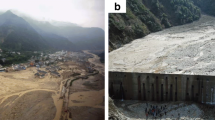Abstract
A particle mapping transportation algorithm was proposed on the basis of the particle-in-cell method. The particles with rectangular influence domains were employed in the transportation algorithm to reduce the numerical fluctuations. Based on the error analysis in the process of particle motion computation, a prediction-correction algorithm was introduced to improve the computational accuracy. Furthermore, the performance of the particle mapping transportation method was evaluated by using the rotation, the slotted disk and the shear advection tests, and the results were compared with other interface reconstruction methods. Finally, the hemispherical projectile penetration into a steel target was numerically simulated. The results showed that the proposed method produced less numerical fluctuations and exhibited clear material interfaces, which indicated that it is accurate and effective.
Similar content being viewed by others
References
Wang C, Ma T B, Lu J. Influence of obstacle disturbance in a duct on explosion characteristics of coal gas. Sci China-Phys Mech Astron, 2010, 53: 269–278
Zhang Y J, Liu Y D, Zhang Z H, et al. Computation on pipe dynamic response induced by deflagration of H2 and air mixture. Sci China-Phys Mech Astron, 2010, 53: 199–208
Ning J G, Song W D, Yang G T. Failure analysis of plastic spherical shells impacted by a projectile. Int J Impact Eng, 2006, 32: 1464–1484
Song W D, Ning J G, Wang J. Normal impact of truncated oval-nosed projectiles on stiffened plates. Int J Impact Eng, 2008, 35: 1022–1034
Wang Z H, Zhang Y F, Ren H L, et al. A study on compressive shock wave propagation in metallic foams. Sci China-Phys Mech Astron, 2010, 53: 279–287
Wu K T, Hao L, Wang C, et al. Level set interface treatment and its application in Euler method. Sci China-Phys Mech Astron, 2010, 53: 227–236
Liu H F, Liu H Y, Song W D. Fracture characteristics of concrete subjected to impact loading. Sci China-Phys Mech Astron, 2010, 53: 253–261
Ren H L, Shu X F, Li Ping. Numerical and experimental investigation of the fracture behavior of shock loaded alumina. Sci China-Phys Mech Astron, 2010, 53: 244–252
Wang G, Wang J T, Liu K X. New numerical algorithms in SUPER CE/SE and their applications in explosion mechanics. Sci China-Phys Mech Astron, 2010, 53: 237–243
Ning J G, Wang C, Lu J. Explosion characteristics of coal gas under various initial temperatures and pressures. Shock Waves, 2006, 15: 461–472
He C J, Zhou H B, Hang Y H. A numerical study on Rayleigh-Taylor instability of aluminum plates driven by detonation. Sci China-Phys Mech Astron, 2010, 53: 195–198
Li P, Bai J S, Wang T, et al. Large eddy simulation of a shocked gas cylinder instability induced turbulence. Sci China-Phys Mech Astron, 2010, 53: 262–268
Wu Y Q, Huang F L. A thermal-mechanical constitutive model for b-HMX single crystal and cohesive interface under dynamic high pressure loading. Sci China-Phys Mech Astron, 2010, 53: 218–226
Liu H F, Ning J G. Mechanical behavior of reinforced concrete subjected to impact loading. Mech Mater, 2009, 41: 1298–1308
Amsden A A. The particle-in-cell method for the calculations of the dynamics of compressible fluids. Los Alamos Scientific Laboratory Report LA-3466. 1966
McKee S. The MAC method. Comput Fluids, 2008, 37: 907–930
Yun S R, Tu H J, Liang D S, et al. Computational Method on Explosion Mechanics. Beijing: Beijing Institute of Technology Press, 1995. 121-126
Nishiguchi A, Yabe T. Second-order fluid particle scheme. J Comput Phys, 1983, 52: 390–413
Konstantinov A B, Orszag S A. Extended lagrangian particle-in-cell code for inhomogeneous compressible flows. J Sci Comput, 1995, 10: 191–231
Brackbill J U, Kothe D B, Ruppel H M. FLIP: A low-dissipation, particle-in-cell method for fluid flow. Comput Phys Commun, 1988, 48: 25–38
Bardenhagen S G, Brachbill J U, Sulsky D. The material-point method for granular materials. Comput Meth Appl Mech Eng, 2000, 187: 529–541
Liu G R, Liu M B. Smoothed Particle Hydrodynamics: A Meshfree particle Method. Singapore: World Scientific Publishing Co. Pte. Ltd., 2003
Ma T B, Wang J, Ning J G. A hybrid VOF and PIC multi-material interface treatment method and its application in the penetration. Sci China-Phys Mech Astron, 2010, 53: 209–217
Harvie D J E, Fletcher D F. A new volume of fluid advection algorithm: The stream scheme. J Comput Phys, 2000, 162: 1–32
Harvie D J E, Fletcher D F. A new volume of fluid advection algorithm: The defined donating region scheme. Int J Numer Meth Fl, 2001, 35: 151–172
López J. A volume of fluid method based on multidimensional ad vection and spline interface reconstruction. J Comput Phys, 2004, 195: 718–742
Rider W J, Kothe D B. Reconstructing volume tracking. J Comput Phys, 1998, 141: 112–152
Scardovelli R, Zaleski S. Interface reconstruction with least-square fit and split Eulerian-Lagragian advection. Int J Numer Meth Fl, 2003, 41: 251–274
Rudman M. Volume-tracking methods for interfacial flow calculations. Int J Numer Meth Fl, 1997, 24: 671–691
Ma T B, Wang C, Ning J G. Multi-material Eulerian formulations and hydrocode for the simulation of explosions. CMES-Comp Model Eng Sci, 2008, 33: 155–178
Ning, J G, Chen L W. Fuzzy interface treatment in Eulerian method. Sci China Ser E-Technol Sci, 2004, 47: 550–568
Børvik T, Langseth M, Hopperstad O S, et al. Perforation of 12 mm thick steel plates by 20 mm diameter projectiles with flat, hemispherical and conical noses Part II: Numerical simulations. Int J Impact Eng, 2002, 27: 37–64
Børvik T, Langseth M, Hopperstad O S, et al. Perforation of 12 mm thick steel plates by 20 mm diameter projectiles with flat, hemispherical and conical noses Part I: Experimental study. Int J Impact Eng, 2002, 27: 19–35
Author information
Authors and Affiliations
Corresponding author
Rights and permissions
About this article
Cite this article
Ren, H., Ma, T. & Yao, X. Numerical studies of penetration problems by an improved particle method. Sci. China Phys. Mech. Astron. 55, 2273–2283 (2012). https://doi.org/10.1007/s11433-012-4948-6
Received:
Accepted:
Published:
Issue Date:
DOI: https://doi.org/10.1007/s11433-012-4948-6




